
by Kaye Dee
I love how our world is drawing closer every day to some of the amazing futures that science fiction has spread before us. I’ve written before about the importance of satellite communications in connecting this divided planet. Just two days ago, 24 countries around the globe were linked together in the first world-spanning live satellite broadcast, titled – appropriately enough – Our World.
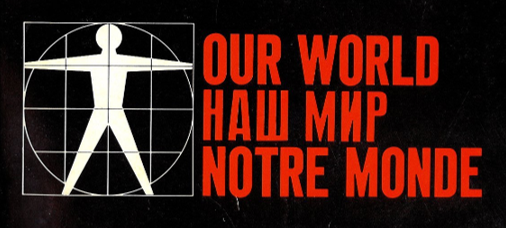
Our World's visual symbol incorporates a modernised version of da Vinci's "Vitruvian Man", with arms encircling the globe, and vertical and horizontal lines representing longitude and latitude
Down Under Comes Up Live – from a town with no television!
For us in Australia, being instantaneously connected to the rest of the world through phone and television is a major step in breaking the “tyranny of distance” that has shaped our national history. Our first Satellite Earth Station was opened just last October in Carnarvon, a remote township in Western Australia, whose only other connection to the rest of the world is a phone line. It’s no wonder NASA wanted to provide a satellite connection back to the United States for its tracking station located there, using the INTELSAT communications network. Just after the station opened, a mishap with the launch of the first INTELSAT II satellite (Blue Bird) on 26 October placed the satellite into the wrong orbit, providing an opportunity for the first satellite broadcast from Down Under.
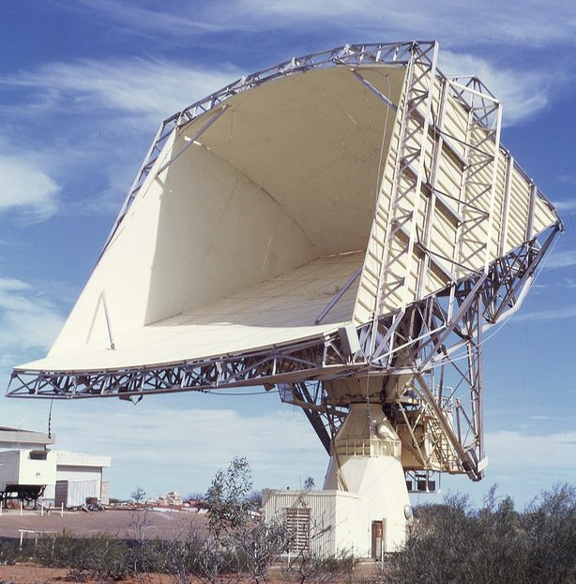
SES Carnarvon's unusual antenna, one of only four that have been built for the INTELSAT network. Officially described a 42-foot aperture cassegrain-fed folded-horn antenna, you can see why it's nicknamed the “sugar scoop”
According to my friend at the Australian Broadcasting Commission (ABC), some hasty calculations revealed that short segments of television broadcast could be relayed to the United Kingdom via INTELSAT II in its unplanned elliptical orbit. So the ABC and the BBC quickly put together a plan for a live telecast, called Down Under Comes Up Live, from Carnarvon – a town which doesn’t even have a television service!
Connection was the theme, and ordinary people were the stars of the show. The program reunited three families of British immigrants living in Carnarvon, two of whom who happened to be employees of the NASA tracking station, with their relatives in the BBC studios in London. It also included some interviews with local residents talking abut life in their remote community. Introducing new babies to family is a universal ritual, and it's delightful to see that it was one that played out in both Down Under Comes Up Live and Our World.
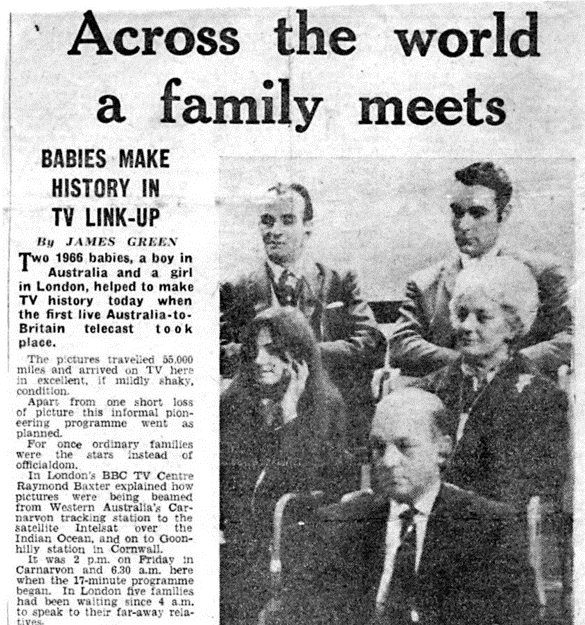
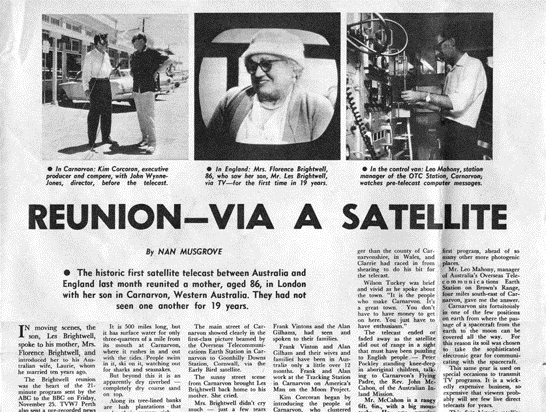
Down Under Comes Up Live was a direct one-way broadcast (a return signal was not possible for technical reasons) that was a complex undertaking (and a good rehearsal for our involvement in Our World). Without a local television station in Carnarvon, ABC outside broadcast vans and their technical staff made a 560 mile trip from Perth to produce the program. The vision was sent live to London from the satellite station, but the audio to and from London was transmitted separately by cable.
On Friday 25 November 1966, more than twelve minutes of television was broadcast to London. Although the program was seen live in the UK, rather ironically, we couldn’t see it live in Australia because there are no television links between Carnarvon and Perth. We had to wait for a few days to see this history-making program, once a film copy of the UK broadcast was flown back to Australia.
Incoming – Australia Day at Expo 67
Apart from a few test transmissions, it was just three weeks ago that we saw the first satellite broadcast into Australia – a live telecast of Australia’s ‘special day’ at Expo 67 in Montreal. This time the transmission came via NASA’s Applications Technology Satellite (ATS)-1. To support this program, NASA has established a temporary satellite station at Cooby Creek dam, about 14 miles north of Toowoomba in Queensland.
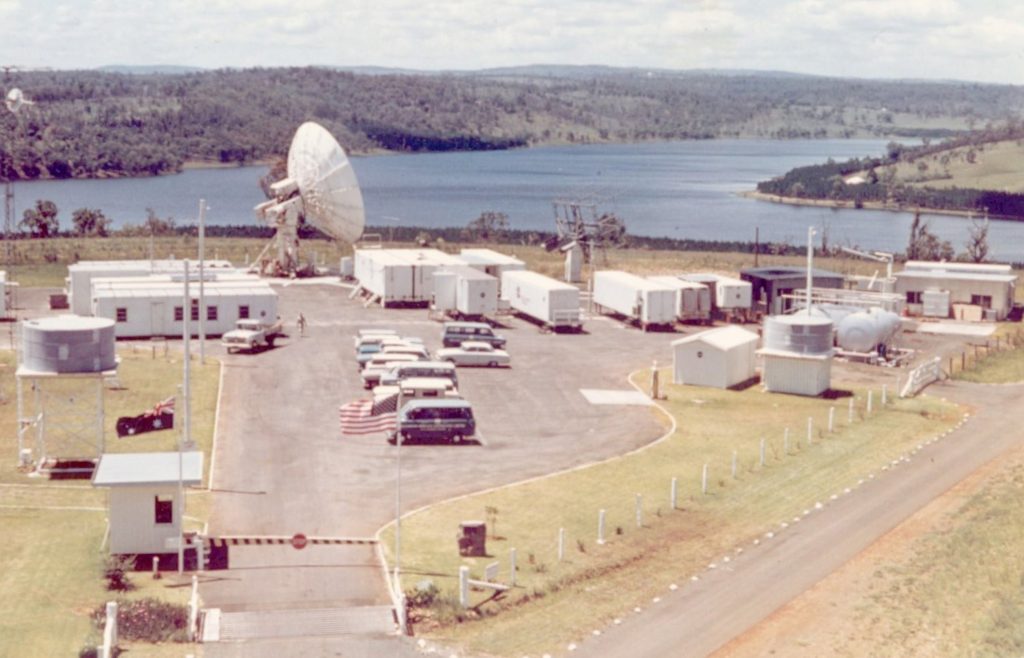
The picturesque setting for NASA's Cooby Creek tracking station that brought both Australia Day at Expo 67 and Our World to Australia via ATS-1
Several hundred thousand people around the country, including my sister’s family and I, watched live through the early hours of 7 June our time, as Australia took centre stage in Canada. The program commenced with Prime Minister Harold Holt officially opening the Australian Pavilion at the Expo. Special events for “Australia Day” included boomerang throwing, sheep-dog trials, wood chopping contests and tennis matches with members of the Australian Davis Cup team. Celebrity was an important theme for the variety concert, "Pop Goes Australia", which showcased Australian talent, including the internationally-known Rolf Harris and The Seekers.
The clarity of the satellite picture from Montreal was surprisingly good: I’ve heard that hundreds of viewers rang the ABC in Sydney wanting to be assured that the vision really was being broadcast live from Canada! I just wish I could find some decent reproductions to show you or had thought to take a picture on the screen of our TV set.
Our World – joining hands (almost) around the planet
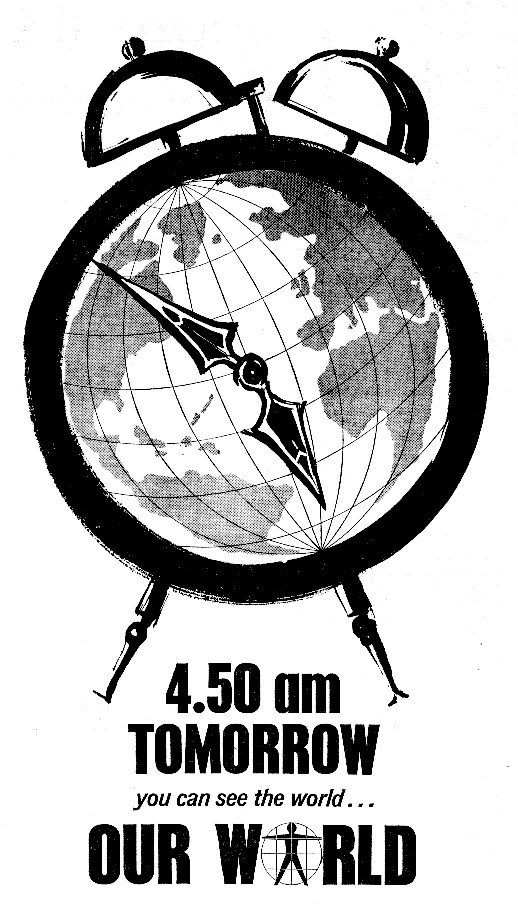 So, with just two satellite broadcasts under its belt, from 4.50am Australian Eastern Time on 26 June, Australia participated in the Our World program, helping to string Puck's "girdle around the world". We joined 13 other nations in providing television content for the first live global television broadcast, which instantaneously linked 24 countries on six continents via four communications satellites, with the signals travelling around the world in just 2 seconds!
So, with just two satellite broadcasts under its belt, from 4.50am Australian Eastern Time on 26 June, Australia participated in the Our World program, helping to string Puck's "girdle around the world". We joined 13 other nations in providing television content for the first live global television broadcast, which instantaneously linked 24 countries on six continents via four communications satellites, with the signals travelling around the world in just 2 seconds!
The brainchild of the BBC, though produced under the auspices of the European Broadcasting Union, the global telecast was controlled from the BBC in London, with America’s National Educational Television in New York City feeding items from the United States, Canada, Mexico, Australia and Japan to the British Control Centre. Literally thousands of technicians handled the outside broadcasts and studio operations around the world. Satellite ground stations in Australia (NASA's Cooby Creek facility again), Japan, Canada, the United States, Britain and France transmitted sound and vision to and from the satellites. As each of the contributing countries provided commentary in their own language, there was also the necessity of rapidly translating the various languages, so that everyone in the receiving countries could understand what was being said.
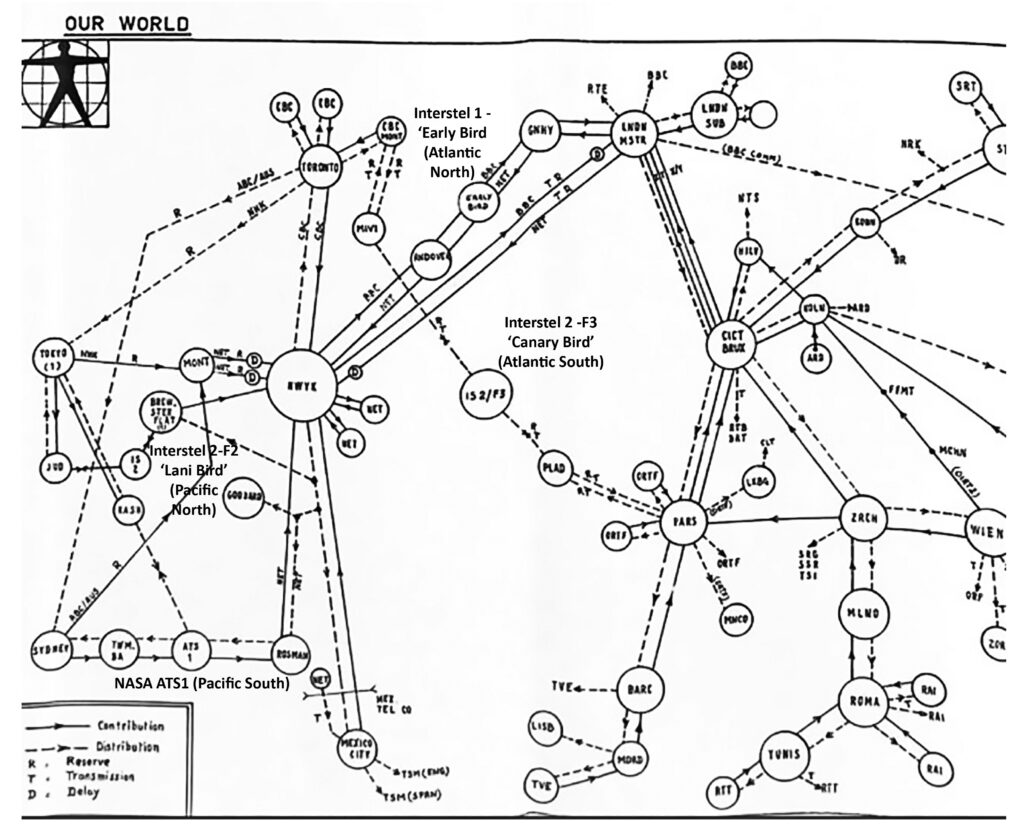
The technical complexity of Our World is evident from this diagram, which shows just part of the world-wide links between television stations and satellites necessary to make the global broadcast a reality
Given the incredible technical complexity of the television transmission, it’s quite amazing that the two-hour program was carried through with very few technical problems – especially when the entire broadcast was televised live, with no filmed insertions or other previously produced material apart from the opening montage. We saw everything as it happened.
Our World was intended as a major achievement for both space technology and international relations, a bridge between East and West in these troubled times of wars cold and hot. Unfortunately, at the last minute, politics reared its ugly head and the USSR and several Eastern European nations that were originally going to participate pulled out of the broadcast just a few days before, as a protest against the recent war in the Middle East. This was disappointing and made for some hurried re-arrangement of parts of the program, but it didn’t dampen the mostly aspirational tone of the broadcast as a celebration of human achievement and hope for a more peaceful future. There was also the irony that a US segment about the Glassboro, New Jersey conference between American president Lyndon Johnson and Soviet premier Alexei Kosygin was still included in the broadcast, although – since the Our World producers insisted that no politicians could be shown – only an external view of the house where the conference was being held was televised.
New Babies and their World
The broadcast crossed countries, seas and time zones, and was presented as fusing “yesterday”, “today” and “tomorrow” (by dint of the different time zones around the world) into a globe-encircling “now”. The birth of several babies across the world opened the program, which was presented in a sense as a “survey” of the world into which these newborns are entering.
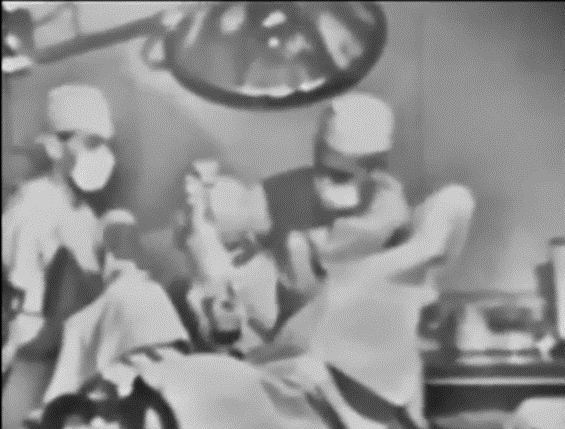
A baby in Mexico, born live on television for all the world to see!
The babies are introduced to their new world through several themes: This Moment's World (what people were doing are doing at that moment around the world); the Hungry World (what scientists are doing to attempt to solve or alleviate the hunger problem); the Crowded World (looking at proposed solutions to the population explosion); Aspiration to Physical Excellence (the continual attempt to develop physical skill); Aspiration to Artistic Excellence (the drive to excel in the arts); and the World Beyond (focussed on astronomy and space travel. Within these themes, vignettes of life and activity from around the world formed the tapestry of the program. Even if some of the actual presentation was, quite frankly, dull and pedestrian (the excitement was, after all, the fact that we were seeing something live from another part of the globe), I thought the concept was an interesting way to approach telling the story of our planet. If an extra-terrestrial civilisation one day happens to intercept this program as its signals travel through space, they'll learn a lot more about the reality of the Earth and its people from Our World than they will get from episodes of I love Lucy.
Everyday Life
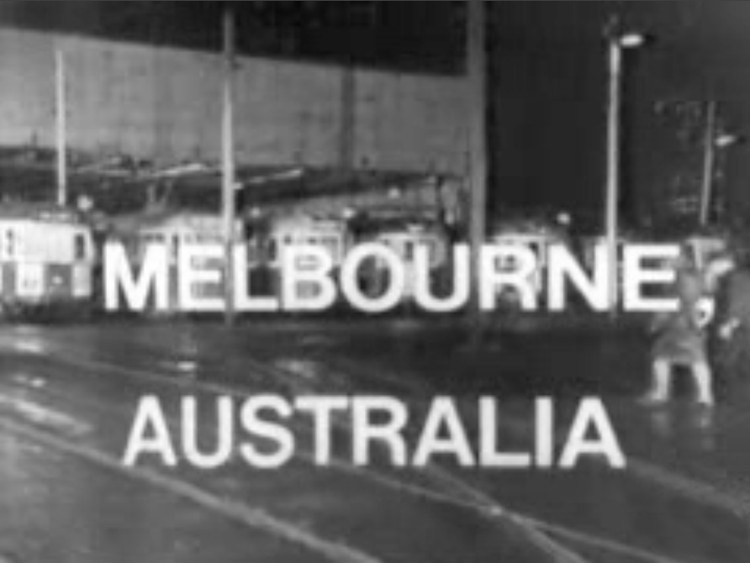
The theme This Moment's World presented a panorama of people and activities in various parts of the globe, moving through evening in Europe to afternoon in New York City, with a visit to Tunis along the way. I loved the views of old and new parts of the city. We saw Marshall McLuhan being interviewed in a Toronto television control room, people swimming at the beach at lunchtime in Vancouver, Canada (making us Aussies all envious on a cold winter's morning) and workmen digging a subway at 4am in Japan. Since the program took place between 5.00 am and 7.00 am Australian Eastern time, our first contribution commenced at 5:22 am local time, with a visit to the Hammer Street Tram Depot in Melbourne, where the first tram of the day was departing to service Monday morning commuters.
This segment was the first cross to the Southern Hemisphere and came directly after the broadcast from Japan. The switch from Japan to Australia was apparently the most technically complicated of the program, as the Japanese and Australian satellite stations had to switch immediately from transmission to receiving mode and back again. The material coming into Australia also had to be converted from the 525-line system to our 625-line format for local broadcast, while the segment going out of Australia had to be converted from 625 to 525-line in order to be sent back to the US and then on to London!
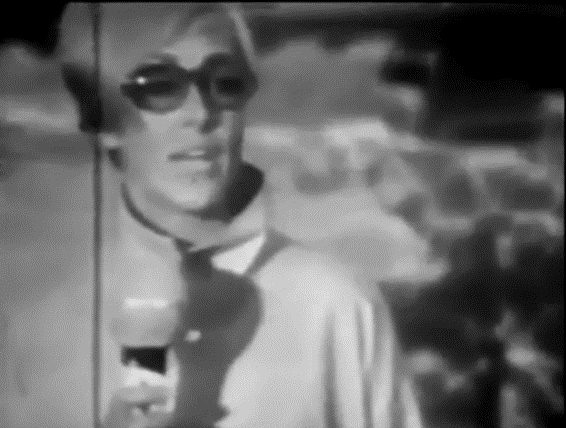
Sweden gave us the first – and almost the only – female presenter in the program!
Global Concerns
Australia also featured in the Hungry World theme, which concentrated on food production and the issues of feeding an ever-growing world population. In addition to items from the United States and a shrimp farm in Takamatsu, Japan, we visited the Canberra phytotron, a laboratory run by the national scientific research agency, CSIRO. In the phytotron, plants can be grown under a wide range of closely controlled climatic conditions. It’s claimed to be one of the world's finest and most up-to-date facilities for plant research, and a number of international scientists work there alongside local researchers.

The CSIRO phytotron's Director, Dr. Lloyd Evans, at work in his plant laboratory. Apparently, he often starts his workday at 5am, so he didn't have to get up earlier than usual for the show!
A couple of segments that were of interest to me in The Crowded World theme were a visit to Cumbernauld (near my father’s home town of Glasgow, Scotland), which was the recipient of an international award for best planning in a new town, and a glimpse of Habitat, a new concept of living accommodation, on display at Expo '67.
Human Achievement
In Aspiration to Physical Excellence, there were contributions from Rome, Sweden, France (where a parachutist made a dizzying free fall with a camera strapped to him), and Winnipeg, Canada, where a 16-year-old Butterfly champion attempted to beat her own world indoor swimming record.
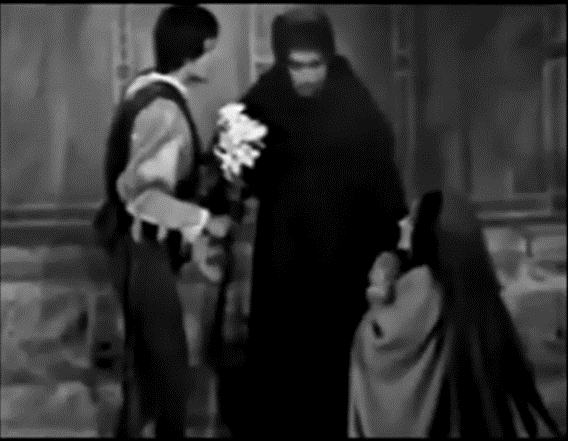
We get to watch live as actors rehearse the wedding scenes from Italian director Franco Zefferelli's next film, Romeo and Juliet
Aspiration to Artistic Excellence included a visit to the Maeght Foundation museum of modern art in France, with artists Marc Chagall and Joan Miro, Leonard Bernstein and pianist Van Cliburn rehearsing Rachmaninoff's Third Piano Concerto. Opera singer Maria Callas, and painter Pablo Picasso also featured. In the context of this theme, it’s interesting to note that the Our World anthem, which accompanied the opening montage was composed by Frenchman Georges Delerue, whose musical score credits includes the recent Academy Award winning motion picture, A Man for All Seasons. He wrote the melody based on the rhythm established by the words “Our World”, sung in 22 different languages by the Vienna Boys’ Choir.
But the highlight of this theme has to be a ‘fly on the wall’ visit to a recording studio where the fabulous Beatles were recording their latest anthem “All You Need is Love”, which was specially written for the Our World broadcast! You can see them below, surrounded by their many friends in the music world, who came to the recording party and became informal backing singers. The black and white shot shows how we saw the FAB Four in the live broadcast, while the colour photo was taken just before the televised performance.
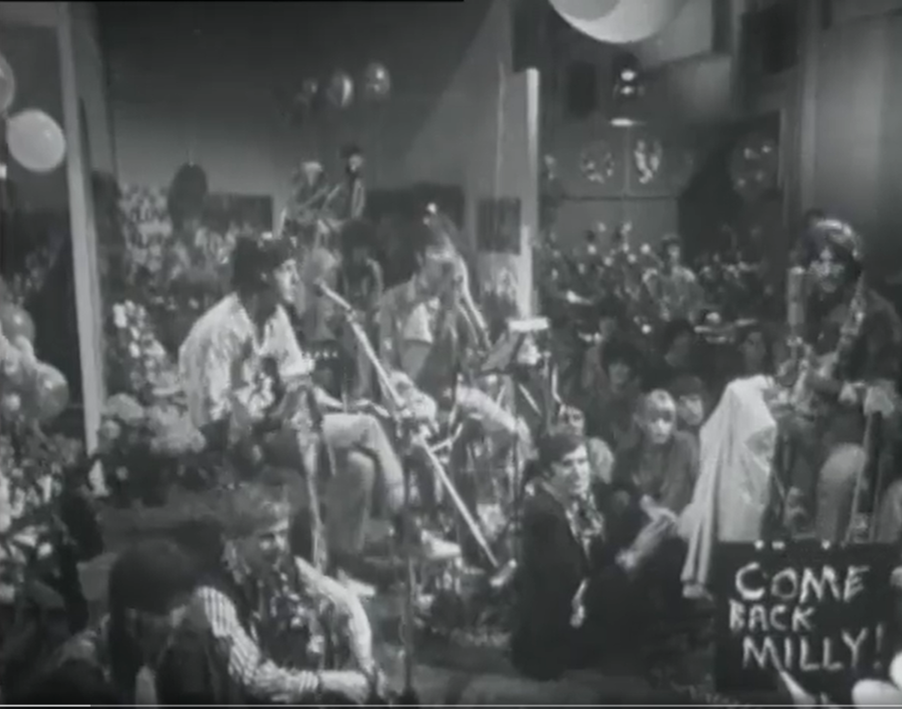

Reaching for the Stars
The World Beyond theme took us to the heart of the Space Race, with a visit to Cape Kennedy to see a Saturn V Moon rocket on the pad being readied for its first flight. The telecast also came to a close on the theme of outer space, with a visit to Australia’s Parkes radio telescope – at 210 ft. the largest fully-steerable radio telescope in the world. Here we sat in on an observation of the most distant object currently known – a mysterious quasar only discovered last year by the Parkes telescope's director, Dr. John Bolton. It’s so far away that its light and radio signals take 13,000 million years to reach us!
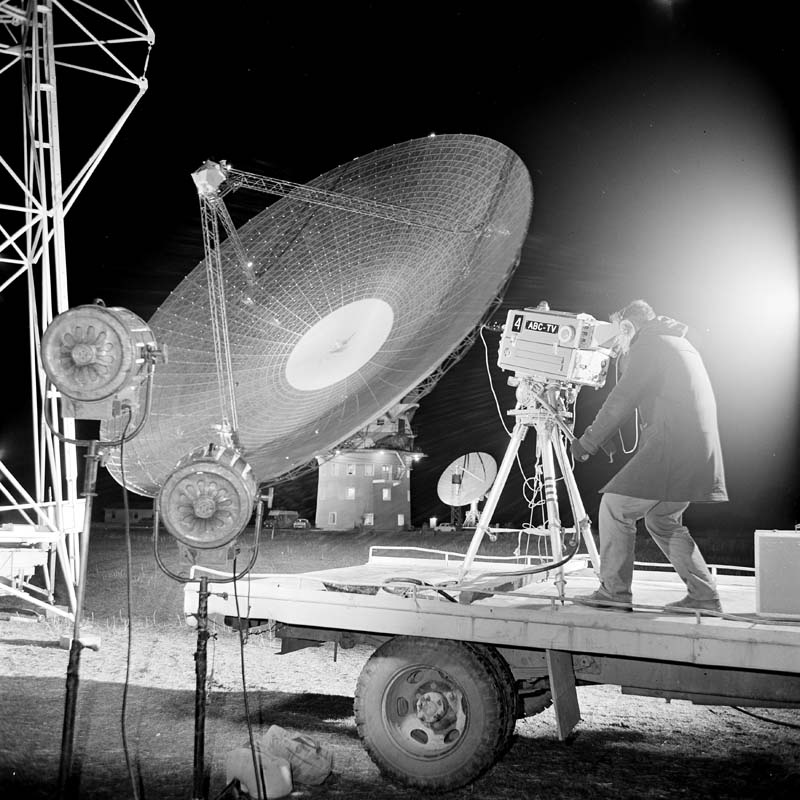
An ABC cameraman, wearing a heavy jacket in the early morning winter cold, prepares for filming the Our World segment at the Parkes Radio Telescope.
So that was Our World. A fascinating mix of banality and creativity, made magical by the technology of the Space Age, and the knowledge that everyone watching was sharing the experience simultaneously with millions of others across our planet in a way that has never before been possible. With a worldwide audience estimated between 350 and 700 million, the broadcast was a potent demonstration of the potential reach of satellite television. I'm sure that before too long, satellite television from around the world will be a regular occurrence, bringing us news, sport, entertainment and major world events – and we here in Australia will have to get used to being up at all hours of the night to watch! But I wonder what will top this broadcast's incredible audience reach? The first manned landing on the Moon, perhaps?


I watched this with my family, and it brought me to tears. I am looking forward to hearing from my friends in Australia and the UK, who I know also watched, to find out what they thought.
Hello, this weekend is good designed for me, as this time i am
Extensive for me. I’m taking a look ahead ?n your subseq?ent publish, I’ll try to get the cling of it!
Ex?e?lent ?nformation you have got here on th?s ?ost.